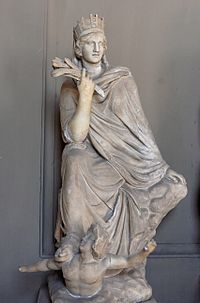Eutychides


Eutychides /juːˈtɪkədiːz/ (Ancient Greek: Εὐτυχίδης, Eutukhídēs) of Sicyon in Corinthia, Greek sculptor of the early part of the 3rd century BC, was a pupil of Lysippus.[1] His most noted work was a statue of the Tyche of Antioch, a goddess who embodied the idea of the then newly founded city of Antioch. The Tyche was seated on a rock, crowned with towers, and having the river Orontes at her feet. There is a small copy of the statue in the Vatican. It was imitated by a number of Asiatic cities; and indeed most statues since created that commemorate cities borrow something from the work of Eutychides.[2]
At the invitation of king Areus, Eutychides spent some time in Sparta, where he made a statue of the Eurotas river, and perhaps another of a seated Herakles, in the 280s or 270s.[3]
List of known works
[edit]- Tyche of Antioch[3]
- Allegory of the Eurotas river, in Sparta[3]
- Allegory of the Nile[3]
- Allegory of the Orontes river[3]
- Herakles seated and reclining on his mace, in Sparta[3]

References
[edit]Attribution:
- This article incorporates text from a publication now in the public domain: Chisholm, Hugh, ed. (1911). "Eutychides". Encyclopædia Britannica. Vol. 9 (11th ed.). Cambridge University Press. p. 958.
Bibliography
[edit]- Bernard Legras & Jacqueline Christien, Dialogues d'histoire ancienne Supplément N° 11, Sparte hellénistique, IVe-IIIe siècles avant notre ère, Presses universitaires de Franche-Comté, 2014. ISBN 978-2-84867-493-3
- Daniel Ogden, The Legend of Seleucus, Kingship, Narrative and Mythmaking in the Ancient Greek World, Cambridge University Press, 2017. ISBN 9781107164789